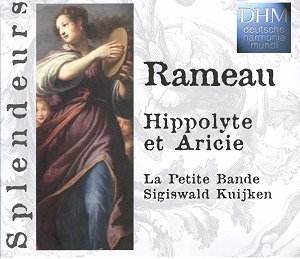Amazingly this recording,
by Sigiswald Kuijken and La Petite Bande,
is over 25 years old. Kuijken and harpsichordist
Gustav Leonhardt founded the group in
1972 and its composition was based on
that of Lully’s orchestra under Louis
XIV. On this disc they are led by Sigiswald
Kuijken with Wieland Kuijken on cello,
Barthold Kuijken on flute and Bob van
Asperen on the harpsichord.
Strictly speaking this
is not a suite at all, but simply a
selection of the dance movements from
the opera. The movements are played
in the order in which they occur in
the opera and though Kuijken has made
a selection from various versions of
the opera (dating from 1733, 1742 and
1757), no attempt has been made to re-organise
the movements so that they make a coherent
whole.
By including some of
the movements from Rameau’s revisions
to the opera, Kuijken enables us to
hear the changes that occur in Rameau’s
orchestration. ‘Hippolyte et Aricie’
was Rameau’s first tragédie
en musique and though written some
50 years after Lully’s last opera, he
still adheres to Lully’s diktats regarding
the orchestra, both in terms of the
disposition of instruments and instrumental
writing, with soprano and bass lines
dominating. But in the third air
des furies from the 2nd
Act of the 1757 version, the horns and
oboes start to take on a harmonic function,
gradually replacing the continuo, rather
then being used melodically as they
were in 1733. Here and in other places
we can see the beginnings of what we
think of as classical orchestration.
As for the performances
themselves, when Nicholas Anderson reviewed
this disc in the Gramophone in 1990
(when it first appeared on CD) he described
the performances as first rate. I am
not sure that I agree. The group do
give performances which are, on the
whole, lively and stylish, though there
are occasional moments when the strings
are untidy and the oboes sound a little
sour. But by the end of the disc I was
finding the performances a little careful
and was rather missing the sense of
élan which other groups have
brought to this music. Also, I began
to long for some vocal contributions.
Rameau had a strong sense of musical
structure and these entr’actes and divertissements
had an important part to play in the
structure of the scenes; there are moments
when the music seems to lack punctuation
because one musical movement leads into
another without the essential intervening
vocal elements.
These are charming,
creditable performances and ‘Hippolyte
et Aricie’ is currently not too well
served on disc. But personally, I would
try and save up for William Christie’s
complete recording.
Robert Hugill


